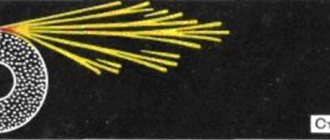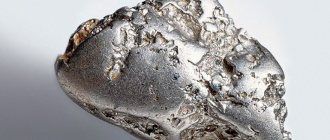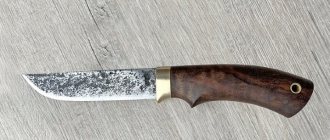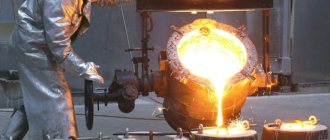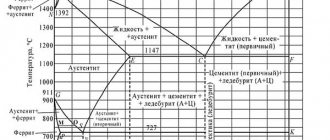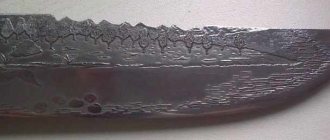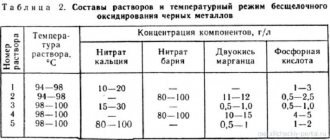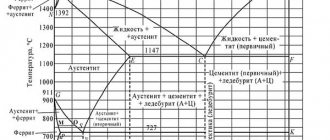How to determine the hardness of metal at home?
Mechanical engineering parts and mechanisms, as well as tools intended for their processing, have a set of mechanical characteristics. Hardness plays a significant role among the characteristics. The hardness of metals clearly shows:
- wear resistance of metal;
- possibility of processing by cutting, grinding;
- resistance to local pressure;
- ability to cut other materials and others.
Hardness of metals
In practice, it has been proven that most of the mechanical properties of metals directly depend on their hardness.
Hardness concept
The hardness of a material is its resistance to destruction when a harder material is introduced into the outer layer. In other words, the ability to resist deforming forces (elastic or plastic deformation).
The hardness of metals is determined by introducing a solid body called an indenter into a sample. The role of the indenter is performed by: a metal ball of high hardness; diamond cone or pyramid.
After exposure to the indenter, an imprint remains on the surface of the test sample or part, the size of which determines the hardness. In practice, kinematic, dynamic, and static methods of measuring hardness are used.
The kinematic method is based on the compilation of a diagram based on continuously recorded readings that change as the tool is pressed into the sample. Here the kinematics of the entire process is traced, and not just the final result.
The dynamic method is as follows. The measuring tool acts on the part. The reverse reaction allows you to calculate the expended kinetic energy. This method allows you to test the hardness of not only the surface, but also a certain volume of metal.
Static methods are non-destructive methods that allow you to determine the properties of metals. The methods are based on smooth indentation and subsequent holding for some time. The parameters are regulated by methods and standards.
The applied load can be applied:
- pressing;
- scratching;
- cutting;
- rebound
Machine-building enterprises currently use the Brinell, Rockwell, Vickers methods, as well as the microhardness method, to determine the hardness of materials.
Based on the tests carried out, a table is compiled indicating the materials, the applied loads and the results obtained.
Hardness Units
Each method of measuring the resistance of a metal to plastic deformation has its own methodology, as well as units of measurement.
The hardness of soft metals is measured using the Brinell method. Non-ferrous metals (copper, aluminum, magnesium, lead, tin) and alloys based on them, cast iron (except for white) and annealed steel are subjected to this method.
Brinell hardness is determined by indentation of a hardened, polished ball made of ShKh15 ball bearing steel. The circumference of the ball depends on the material being tested. For hard materials - all types of steel and cast iron - 10 mm, for softer materials - 1 - 2 - 2.5 - 5 mm. Required load applied to the ball:
- iron alloys – 30 kgf/mm2;
- copper and nickel – 10 kgf/mm2;
- aluminum and magnesium – 5 kgf/mm2.
The unit of hardness measurement is a numerical value followed by a numerical index HB. For example, 200 NV.
Rockwell hardness is determined by the difference in applied loads to the part. First, a preliminary load is applied, and then a general load, at which the indenter is introduced into the sample and held.
A pyramid (cone) of diamond or a ball of tungsten carbide (hardened steel) is introduced into the test sample. After removing the load, the depth of the indentation is measured.
The unit of measurement for hardness is conventional units. It is generally accepted that one is the amount of axial displacement of the cone, equal to 2 μm. The hardness designation is marked with three letters HR (A, B, C) and a numerical value. The third letter in the marking indicates the scale.
The technique reflects the type of indenter and the load applied to it.
| Scale type | Tool | Applied load, kgf |
| A | Diamond cone with 120° apex angle | 50-60 |
| IN | 1/16" ball | 90-100 |
| WITH | Diamond cone with 120° apex angle | 140-150 |
Basically, measurement scales A and C are used. For example, the hardness of steel is HRC 26...32, HRB 25...29, HRA 70...75.
Products of small thickness or parts with a thin, hard surface layer are measured by Vickers hardness. The blade used is a regular tetrahedral pyramid with an apex angle of 136°. The display of hardness values is as follows: 220 HV.
Hardness measurement using the Shore method is carried out by measuring the rebound height of a fallen striker. Indicated by numbers and letters, for example, 90 HSD.
Microhardness is determined when it is necessary to obtain the values of small parts, thin coatings, or individual alloy structures. The measurement is made by measuring the imprint of a tip of a certain shape. The value notation looks like this:
Н□ 0.195 = 2800, where
□ — tip shape;
0.196 — tip load, N;
2800 – numerical value of hardness, N/mm2.
Hardness of base metals and alloys
The hardness value is measured on finished parts sent for assembly. Control is carried out for compliance with the drawing and technological process. Tables of hardness values have already been compiled for all basic materials, both in the initial state and after heat treatment.
Non-ferrous metals
The Brinell hardness of copper is 35 HB, the values of brass are 42-60 HB units, depending on its brand. For aluminum, the hardness is in the range of 15-20 HB, and for duralumin it is already 70 HB.
Rockwell hardness
The hardness of materials is an integrating indicator of their mechanical properties. There is an empirical correspondence between the hardness value and a number of mechanical properties (for example, compressive, tensile or bending strength).
With the development of mechanical engineering, the need arose to have general methods for measuring hardness. At the beginning of the 20th century, Professor Ludwig developed the theoretical part of the method for determining hardness with a diamond cone. In 1919, Hugh and Stanley Rockwell patented a hydromechanical device, which was named the Rockwell hardness tester.
The relevance of this device is caused by the need to use non-destructive methods of hardness control in the bearing industry. The existing Brinell (HB) method is based on measuring the indentation area of a 10 mm diameter ball.
The imprint is formed using a ball of hardened steel or tungsten carbide, which is pressed into the sample with a certain force. The Brinell method is used to determine the hardness of non-ferrous metals or low-alloy steels and is not applicable to hardened steel samples.
This is due to the fact that the working load is 3000 kgf. The ball is deformed, so the Brinell method cannot be considered a non-destructive testing method.
Rockwell hardness test method
Hardness is a characteristic of a material that is opposite to plasticity, the ability of a material to “flow” under load. The Rockwell hardness measurement technique is intended for non-destructive testing of the hardness of the least ductile materials - steels and their alloys.
The versatility of the method lies in the presence of three hardness scales, which are calibrated for measurement under one of three loads (60, 100 and 150 kgf) to work with one of the measuring heads.
A diamond cone with an angle of 120° and an apex radius of 0.2 mm or a hardened ball with a diameter of 1/16“ (1.588 mm) is used as the working body of the measuring head.
The method is based on recording the direct measurement of the depth of penetration of a solid body by a measuring head (indenter) into the sample material. The depth of the indentation characterizes the ability of the material to resist external influences without forming a roll of displaced metal around the indenter.
The Rockwell hardness unit is a dimensionless value, which is expressed in conventional units up to 100. The displacement of the indenter by 0.002 was taken as a unit of hardness.
Metal hardness according to Rockwell: table
The table was created for a visual comparison of the Rockwell and Brinell methods.
| According to Rockwell | According to Brinell | |||
| HRACone 120° load. 60 kgf | HRCone 120° loaded 150 kgf | HRB Ball Ø 1.58 mm load. 100 kgf | Diameter of printsmm | HBball Ø 10 mmload. 3000 kgf |
| 84,5 | 65 | — | 2,34 | 688 |
| 83,5 | 64 | — | 2,37 | 670 |
| 83 | 63 | — | 2,39 | 659 |
| 82,5 | 62 | — | 2,42 | 643 |
| 82 | 61 | — | 2,45 | 627 |
| 81,5 | 60 | — | 2,47 | 616 |
| 81 | 59 | — | 2,5 | 601 |
| 80,5 | 58 | — | 2,54 | 582 |
| 80 | 57 | — | 2,56 | 573 |
| 79 | 56 | — | 2,6 | 555 |
| 79 | 55 | — | 2,61 | 551 |
| 78,5 | 54 | — | 2,65 | 534 |
| 78 | 53 | — | 2,68 | 522 |
| 77,5 | 52 | — | 2,71 | 510 |
| 76 | 51 | — | 2,75 | 495 |
| 76 | 50 | — | 2,76 | 492 |
| 76 | 49 | — | 2,81 | 474 |
| 75 | 48 | — | 2,85 | 461 |
| 74 | 47 | — | 2,9 | 444 |
| 73,5 | 46 | — | 2,93 | 435 |
| 73 | 45 | — | 2,95 | 429 |
| 73 | 44 | — | 3 | 415 |
| 72 | 42 | — | 3,06 | 398 |
| 71 | 40 | — | 3,14 | 378 |
| 69 | 38 | — | 3,24 | 354 |
| 68 | 36 | — | 3,34 | 333 |
| 67 | 34 | — | 3,44 | 313 |
| 67 | 32 | — | 3,52 | 298 |
| 66 | 30 | — | 3,6 | 285 |
| 65 | 28 | — | 3,7 | 269 |
| 64 | 26 | — | 3,8 | 255 |
| 63 | 24 | 100 | 3,9 | 241 |
| 62 | 22 | 98 | 4 | 229 |
| 61 | 20 | 97 | 4,1 | 217 |
| 60 | 18 | 95 | 4,2 | 207 |
| 59 | — | 93 | 4,26 | 200 |
| 58 | — | — | 4,34 | 193 |
| 57 | — | 91 | 4,4 | 187 |
| 56 | — | 89 | 4,48 | 180 |
(*) — The presented table of correspondence between hardness on the Rockwell HRA, HRC and HRB scales and hardness on the Brinell scale is for reference only and cannot be used for applied solutions. For technical use, one should rely on data according to GOST 8.064-79 for the Rockwell scales HRA, HRC and Super-Rockwell HRN, HRT, the values in which are reduced to the reference value HRCе.
How does the Rockwell hardness scale work?
11 scales have been developed for determining hardness (A...H, K, N, T), which are designed to work in various combinations of “intendent - load”. For example, scales B, F and G are used for measuring a ball Ø 1.588 with a load on scales B, F - 60 kgf and on scale G - 150 kgf. For scales E, H and K, a Ø 3.175 mm ball with different loads is used.
The following scales are common:
- A - with a cone and a total force on the measuring head of 60 kgf (10 kgf - preliminary load plus 50 kgf - main load).
- B - with a ball Ø 1.588 and a total force on the measuring head of 100 kgf.
- C - with a cone and a total force on the measuring head of 150 kgf.
The preload, which allows you to select hardness tester gaps and destroy the oxide film on the sample, is the same for measurements using any scale.
A dial-type device is used as an indicator, which allows recording the movement of the indenter by 0.002 mm, taking into account the movement of the levers. The maximum movement of the measuring head under working load is 0.2 mm. The indicator contains a scale containing 100 divisions for each measurement method (for example, TK 2 or NOVOTEST TS-R).
Measuring ranges for scales (materials):
- HRA - 20...88 units. (corrosion-resistant and heat-resistant steels)
- HRB - 20...100 units. (copper alloys, ductile iron, low-carbon steels)
- HRC - 20...70 units. (high carbon steels after heat treatment)
Scales A and C are combined, scale B is highlighted in color or displayed separately.
Rockwell hardness tester: what is it and how does it work?
The stationary hardness tester is a solid-cast rigid U-shaped structure (laid on its side) and consists of 2 blocks:
- The measuring unit (top) consists of a dial indicator, which is in contact with the load suspension lever. To eliminate the occurrence of shock loads when the indentation mode is turned on, the suspension arm has a hydraulic damper.
- The installation movement block (bottom) consists of a screw pair with a large pitch for manual movement of the table. The screw pair is used to create preload and large movements of the table. This makes it possible to measure hardness on parts with dimensions much larger than the dimensions of a 20 mm thick sample. The hardness of the table surface is not lower than HRC 50.
Hardness testers may have a displacement motor, an electronic measurement system with a display, and other improvements that do not affect the measurement technique.
Measurements are carried out under normal conditions (temperature - 18...23° C, humidity 70...80%).
Sample requirements:
- the sample (part) must lie stable, not spring, not wobble;
- the surface roughness of the sample is not lower than Ra 2.5 according to GOST 2789-73.
A sample is made for a batch of parts, which undergoes heat treatment along with the parts.
Operating procedure:
- the sample is placed on the table;
- using a lead screw, the sample is brought to the intendor and pre-loaded (the indicator is set to 0);
- the lever (button) turns on the mode of pressing the intendor into the sample;
- when the indicator arrow stops (2...8 seconds after loading), the main load is removed and the hardness value is read.
Modern Rockwell hardness testers, equipped with digital measuring systems, have devices for automatic approach, preloading, control of the amount of force and time of the working load. All improvements must ensure compliance with the requirements of GOST 23677-79.
Pros and cons of the method
The main advantage of the Rockwell hardness measurement method is its versatility. Measurements are carried out with three variable parameters, which allows expanding the scope of its application.
Other advantages of the method:
- refers to non-destructive methods (can be used to control finished products);
- allows you to control cylindrical products in a prism with a diameter of 6 mm or more or with surface curvature R3, taking into account amendments (Appendix 3 according to GOST 9013-59 “ISO 6508-86”);
- allows you to control sheet material with a thickness of 0.3...1.0 mm on the HRA scale (super Rockwell);
- short measurement time (no more than 2 minutes with testing on a control sample);
- ease of reading the results.
The disadvantages include lower accuracy and repeatability of measurements compared to the Brinell and Vickers methods. However, the disadvantages are fully compensated by the advantages.
How to determine the hardness of a metal at home - Metals, equipment, instructions
Mechanical engineering parts and mechanisms, as well as tools intended for their processing, have a set of mechanical characteristics. Hardness plays a significant role among the characteristics. The hardness of metals clearly shows:
- wear resistance of metal;
- possibility of processing by cutting, grinding;
- resistance to local pressure;
- ability to cut other materials and others.
Hardness of metals
In practice, it has been proven that most of the mechanical properties of metals directly depend on their hardness.
Black metals
The Rockwell hardness of cast iron SCH20 HRC 22, which corresponds to 220 HB. Steel: tool – 640-700 HB, stainless steel – 250 HB.
To convert from one measurement system to another, tables are used. The values in them are not true, because they are derived imperially. Not the full volume is presented in the table.
| HB | H.V. | H.R.C. | HRA | HSD |
| 228 | 240 | 20 | 60.7 | 36 |
| 260 | 275 | 24 | 62.5 | 40 |
| 280 | 295 | 29 | 65 | 44 |
| 320 | 340 | 34.5 | 67.5 | 49 |
| 360 | 380 | 39 | 70 | 54 |
| 415 | 440 | 44.5 | 73 | 61 |
| 450 | 480 | 47 | 74.5 | 64 |
| 480 | 520 | 50 | 76 | 68 |
| 500 | 540 | 52 | 77 | 73 |
| 535 | 580 | 54 | 78 | 78 |
Hardness values, even if produced by the same method, depend on the applied load. The lower the load, the higher the readings.
Hardness measurement methods
All methods for determining the hardness of metals use mechanical action on the test sample - indentation of an indenter. But this does not destroy the sample.
The Brinell hardness method was the first to be standardized in materials science. The principle of testing samples is described above. It is subject to GOST 9012. But you can calculate the value using the formula if you accurately measure the imprint on the sample:
HB=2P/(πD*√(D2-d2),
- where P – applied load, kgf;
- D – ball circumference, mm;
- d – circumference of the imprint, mm. The ball is selected relative to the thickness of the sample. The load is pre-calculated from accepted standards for the relevant materials: iron alloys - 30D2; copper and its alloys - 10D2; babbits, lead bronze - 2.5D2.
Symbol of the test principle
Download GOST 9012-59
Schematically, the Rockwell research method is depicted as follows according to GOST 9013.
How to determine the hardness of metal at home
Mechanical engineering parts and mechanisms, as well as tools intended for their processing, have a set of mechanical characteristics. Hardness plays a significant role among the characteristics. The hardness of metals clearly shows:
- wear resistance of metal;
- possibility of processing by cutting, grinding;
- resistance to local pressure;
- ability to cut other materials and others.
Hardness of metals
In practice, it has been proven that most of the mechanical properties of metals directly depend on their hardness.
How to choose a knife in general
Before purchasing a knife, you should decide for what purposes you will use it. If it is a sharp cutter, then you should not test it too hard; the minimum sharpening angle will not withstand such abuse, no matter what kind of steel is on this knife. You need to understand how much you can spend on a knife. Two blades made of different steels that are completely identical in appearance will cut differently. The higher quality the steel, the more durable the cutting edge will be.
Much depends on what kind of slope the blade has. If you plan to use the knife mainly for food, then Scandinavian blades are not the best option, although they are ideal for a universal knife. I’ll say right away about the Scandinavians - it’s not just my opinion that they are the best universal knives in the world, this turns out to be the case based on international statistics.
Before buying a knife, ask the seller if he will allow you to test the knife for sharpness, at least in “light” mode. No one will let you cut wire and “loaf” logs, but they should allow you to shred newspaper.
Hardness of metals
Mechanical engineering parts and mechanisms, as well as tools intended for their processing, have a set of mechanical characteristics. Hardness plays a significant role among the characteristics. The hardness of metals clearly shows:
- wear resistance of metal;
- possibility of processing by cutting, grinding;
- resistance to local pressure;
- ability to cut other materials and others.
Hardness of metals
In practice, it has been proven that most of the mechanical properties of metals directly depend on their hardness.
How to test the hardness of metal - the main secrets
When it comes to metals, an important indicator is its hardness.
A factor of this kind plays a significant role in the choice of whether or not to use a particular metal in production for the manufacture of products for a specific purpose.
It is worth understanding this issue in more detail, which requires testing the hardness of metal in the production line of various industries.
What is metal hardness
This concept refers to a characteristic closely related to metals and their alloys. This is the ability to resist damage when the top layer is synchronized with a harder metal.
Based on this knowledge, various equipment and parts are manufactured that play a role in the durability of objects, structures, machines, and tools. Simply put, resistance to deformation.
You can check this parameter in different ways.
Methods for testing metal hardness
Experts distinguish several options for checking characteristics:
- According to the Brinnell method, a steel ball takes part in the verification process. It is pressed under great pressure into a metal surface. Then a special magnifying glass comes into effect, and with its help the specialist measures the diameter of the hole. Hardness is determined from tabular data. This method is the first method for determining the nature of the metal. This is how soft alloys are measured.
- Rockwell's technique involves impacting a metal surface with a diamond cone. A special press is used to measure the hardness of soft, colored, thin Me. It is not considered very accurate, although it is successfully used for the study of hard alloys.
- Similar actions to the previous one are included in the Vikxer method, which involves turning to a diamond pyramid, only the angle of the top is not 120, but 136 degrees. The load is carried out strictly perpendicular to the metal and increases slowly. Refers to high-precision methods.
- Shore's method involves the presence of a striker with a diamond-coated tip. It falls from a specific height onto the surface of the material being tested. Hardness is measured by the height of the striker's rebound. This methodology is distinguished by a large scatter of readings; for the most part it is used to measure curved objects and large parts.
At home, the indicator is also measured, but you should not expect high accuracy. When you turn to professionals, you can get a highly accurate result, and this is a crucial moment.
Some conduct home education to determine this value, using an ordinary bottle and scratching it with a metal object, for example, a knife blade.
Metal of 62 units easily scratches glass, which cannot be said about 56 units.
What does the hardness of the metal indicate, what does it give
The question arises as to why this parameter needs to be measured at all. The characteristics of metals are important to those involved in the steel heat treatment industry. The conclusion about the mechanical properties of the weld is also obtained by studying the heat-affected surface.
The feasibility of the research being carried out is also predetermined by the intention of manufacturers to obtain high-strength products so that they can withstand different operating conditions, temperature changes, and ensure reliability. The hardness of a metal product is a primary structural characteristic.
Research is carried out with the following objectives.
- Analyze the state of the material under the influence of time.
- Obtain knowledge of likely destructive consequences to improve operational capabilities.
- Monitor the results obtained as part of the temperature treatment.
According to the information acquired during the experiments, it is possible to determine the resistance to abrasion and wear of the source material.
Conclusion
To carry out the analysis, certain conditions are imposed on the material being tested. In particular, the workpiece is selected to be level. It should fit tightly to the hardness tester, with carefully processed edges.
As a result, fundamental mechanical quality is achieved, which plays a role in the production of high-quality products.
Specialists use the results obtained during the study, compare them with previously known analysis, and this is a lot of work that helps determine the production methodology. Information is necessary for mechanical engineering, metalworking, and metallurgical enterprises.
The concept of “hardness” is associated with elasticity, plasticity, and strength, although there is no direct connection between mechanical qualities. It is important to turn to professionals to perform such work; the home method is only suitable for tasks of hardening knives.
Tests you can do right in the store
The simplest test
, which can be done without prior preparation, is a shaving test for the hair on the forearm. You don’t even have to ask the seller for permission, just run the blade across your forearm. A well-sharpened knife will shave hair easily. You should not be afraid of this test, although it is scary to check the quality of sharpening on your hand for the first time. The main thing is not to press the blade on the skin and hold it at a certain angle. It’s difficult to explain this in words, just try it and everything will work out (just be careful!).
The next test is paper cutting
. If the blade does not shave hair, then at least it must cut paper. In the worst case, sheets of A4 size writing paper, in the best case, a newspaper. This test will show how responsibly the manufacturer took such a procedure as sharpening the blade. Take a sheet and start shredding the paper. If the paper tears, it is better to immediately refuse to purchase such a knife. Although sharpening it is not a problem, this already indicates that the manufacturer was negligent in making the knife.
A good knife will do a great job of whittling paper and you'll just get tired of doing it before it gets dull. But if the knife first cuts the paper and then begins to tear it, it means either the steel is bad or the thermal agent has let us down.
Steel homogeneity test
. To be honest, I seriously doubt its effectiveness, and I would not recommend focusing on its indicators. They say you just need to wipe the knife blade dry and then breathe on it. By the way the perspiration comes off, you can understand the homogeneity of the metal. To me this sounds like nonsense, before this test the knife needs to be at least degreased, otherwise the fatty places on the blade will be different anyway. It's possible that this test works, but I don't believe it.
Sound test
allows you to determine the quality of hardening. A similar method was used in Rus'. This is exactly how axes were tested, and even now many of them are tested in stores this way. It works pretty much the same way on knives. You need to take the tool by the end of the handle, after which you need to click the blade with your fingernail. If the sound is ringing and long, it means the hardening is good. It should be especially noted that folding knives cannot be checked in this way.
